
Original Link: https://www.anandtech.com/show/423
Intel Pentium III 800 & 750 "Coppermine"
by Anand Lal Shimpi on December 20, 1999 4:28 AM EST- Posted in
- CPUs
Intel has had a rough end to 1999: the delay of the 820 chipset made the launch of the Coppermine a relatively slow one and the price of RDRAM has kept most 820 based motherboards out of the hands of users who are considering the new Pentium IIIs. How can you expect to sell a platform that supports memory that carries a price tag greater than the most expensive desktop Intel CPU you could run on it?
Intel is not used to be put in this position by AMD. For almost two years, they held the advantage over AMD, but now with the release of the Athlon, Intel is quickly getting used to a competition that is based on clock speed once again.
From the start, AMD's Athlon has had platform problems, but so has Intel's Coppermine. In the ideal scenario, the Pentium III based on the Coppermine core was supposed to be released with the i820 chipset, the true successor to the BX, then everyone that owned a BX board would upgrade and all would be well. That's not how it has happened, the i820 platform is a very undesirable platform simply due to the incredible cost of RDRAM. Adding on a Memory Translator Hub (MTH) to an 820 board does allow for the use of SDRAM but ends up being slower than the 'old' BX + SDRAM configuration, a much cheaper alternative.
The i840 chipset comes into the light offering faster memory performance than the i820, courtesy of its two RDRAM channels (totaling a whopping 3.2GB/s of memory bandwidth), but this does not hide the fact that RDRAM isn't cheap at all. Upgrading an already smooth running server or workstation with 1GB of SDRAM to an equivalently configured i840 system would rack up close to $8000 in memory cost alone! Not very cost effective at all.
This virtually exhausts Intel's chipset lineup (we are purposefully leaving out the i810E as a viable option for a $700 processor), which isn't good news at all. Moving towards the 133MHz FSB, faster memory options, and AGP 4X are all positive ideas, but the correct path has yet to be taken by Intel. Unfortunately, they can't just forget about the i820 and work on something else, which puts them in an awkward situation: Intel has to release both 133MHz and 100MHz FSB Pentium III CPUs until their 133MHz platform becomes a realistic option.
For this reason, Intel has a more difficult time keeping up with AMD's increasingly high clock speeds because they have to make sure that they have a 133MHz FSB part as well as a 100MHz FSB part to tailor to the needs of their OEMs that will not make the switch to the 133MHz FSB platform. And thus we have the introduction of the Pentium III 800 which is a 133MHz FSB CPU and the Pentium III 750, a 100MHz FSB CPU.
The Coppermine Confusion
There are entirely too many different Intel CPUs on the market. That is as plainly as it can be put, and for someone looking to purchase a new CPU, seeing the overwhelming number of Pentium IIIs on the market can be very intimidating. In an effort to help clear up any confusion, let's take a look at all the different Pentium IIIs on the market today:
Pentium III 450/500/550
These four CPUs are based on the original Pentium III core, which carried the code name Katmai. The Katmai core features the 70 Streaming SIMD Extensions (SSE) and the Processor Serial Number that drew so much attention upon its conception.
They feature 512KB of L2 cache, located on the Slot-1 processor card, operating at ½ the core clock frequency. They operate on a 100MHz FSB and run at a 2.0v core voltage. The Katmai core is manufactured on a 0.25-micron fabrication process, features approximately 9.5 million transistors, and measures in at 128 mm^2.
Pentium III 600
The Pentium III 600 is from the same family as the 450 - 550MHz parts, the only difference is that it runs at a 2.05v core voltage setting.
Pentium III 533/600B
These two CPUs were released into 2H of 1999 and are still based on the Katmai core. The only difference is that they are 133MHz FSB CPUs, meaning they have lower clock multipliers and are intended for use on 133MHz FSB platforms (i.e. 820, 840, Apollo Pro 133A, etc…). As with the Pentium III 600, the 600B runs at 2.05v. The 533 runs at the standard 2.0v.
Pentium III 500E/550E
While all of the aforementioned CPUs are Slot-1 processors, the Pentium III 500E/550E are both Socket-370 processors. These two chips are based on the new Coppermine core that was just introduced in October 1999.
The Coppermine core is manufactured on a 0.18-micron process that allows for the die to shrink down to 106 mm^2 from 128 mm^2 while providing enough room for a full 256KB of L2 cache on the die itself thus removing the need for a processor card to house the L2 cache. The Coppermine core contains other performance enhancements in addition to the full speed on-die 256KB L2 cache which you can learn about in our review of the Pentium III "Coppermine."
Both of these CPUs run on the 100MHz FSB and feature a 1.60v core voltage requirement.
Pentium III 533EB/600EB/667/733/800Like the Pentium III 500E/55E, these five CPUs are all based on the 0.18-micron Coppermine core and thus feature a full speed on-die 256KB L2 Cache. The only differences are that they run at 1.65v and are available in Slot-1 versions only. They run at a 133MHz FSB.
Pentium III 600E/650/700/750
These four are all based on the 0.18-micron Coppermine core like the Pentium III 500E/550E. The only differences are that they run at 1.65v and are available in Slot-1 versions only. Unlike the previous five, these run at a 100MHz FSB and will therefore work on some BX boards.
The Test
Taken from our AMD Athlon 800 Review
This review wasn't intended to be a massive CPU roundup, rather a comparison of 700MHz+ Athlon processors amongst themselves as well as to their Pentium III counterparts. For more Athlon performance scores visit our previous CPU reviews.
|
Windows 98 SE Test System |
|||
|
Hardware |
|||
|
CPU(s) |
Intel
Pentium III 750 |
Intel
Pentium III 800
|
AMD
Athlon 800
AMD Athlon 750 AMD Athlon 700 |
| Motherboard(s) |
AOpen
AX6BC Pro-II
|
AOpen
AX6C
|
Gigabyte
GA-7IX
|
| Memory |
128MB PC133 Corsair SDRAM |
128MB
PC800 Samsung RDRAM
|
128MB
PC133 Corsair SDRAM
|
| Hard Drive |
IBM Deskstar DPTA-372050 20.5GB 7200 RPM Ultra ATA 66 |
||
| CDROM |
Phillips 48X |
||
| Video Card(s) |
NVIDIA GeForce 256 32MB (default clock - 120/166) |
||
| Ethernet |
Linksys LNE100TX 100Mbit PCI Ethernet Adapter |
||
|
Software |
|||
|
Operating System |
Windows 98 SE |
||
| Video Drivers |
|
||
|
Benchmarking Applications |
|||
| Gaming |
GT
Interactive Unreal Tournament 4.04 UTbench.dem |
||
| Synthetic |
Distributed.net
RC5 Client CSC Cracking Test
|
||
| Productivity |
BAPCo
SYSMark 98
BAPCo SYSMark 2000 Ziff Davis Content Creation Winstone 2000 |
||
|
Windows NT SP6 Test System |
|||
|
Hardware |
|||
|
CPU(s) |
Intel
Pentium III 750 |
Intel
Pentium III 800
|
AMD
Athlon 800
AMD Athlon 750 AMD Athlon 700 |
| Motherboard(s) |
AOpen
AX6BC Pro-II
|
AOpen
AX6C
|
Gigabyte
GA-7IX
|
| Memory |
128MB PC133 Corsair SDRAM |
128MB
PC800 Samsung RDRAM
|
128MB
PC133 Corsair SDRAM
|
| Hard Drive |
IBM Deskstar DPTA-372050 20.5GB 7200 RPM Ultra ATA 66 |
||
| CDROM |
Phillips 48X |
||
| Video Card(s) |
NVIDIA GeForce 256 32MB (default clock - 120/166) |
||
| Ethernet |
Linksys LNE100TX 100Mbit PCI Ethernet Adapter |
||
|
Software |
|||
|
Operating System |
Windows 98 SE |
||
| Video Drivers |
|
||
|
Benchmarking Applications |
|||
| Professional |
3D
Studio MAX R2
SPECviewperf 6.1.1 |
||
| Productivity |
BAPCo
SYSMark 98
Ziff Davis Content Creation Winstone 2000 |
||

ZD's Content Creation Winstone 2000 taxes the system in a much more effective way than the old Business Winstone 99 used to. The result is a more accurate representation of overall system performance under content creation applications. In spite of its slower L2 cache, the Athlon 800 manages to pull ahead of the pack by a small margin. In this test, the Athlon seems to hold its ground above the Pentium III on a clock for clock basis, although in some cases not by a large performance advantage.

SYSMark 2000, unlike its predecessor SYSMark 98, features more up to date versions of the applications included in the benchmark. Many of them happen to boast SSE optimizations that help keep Intel's measurable but not noticeable advantage over AMD.

While this last benchmark isn't a real world test, we decided to include it as a sort of "drool-inducer" for the members of Team AnandTech, our very own RC5 cracking team. The Athlon 800 will be cracking for us in the lab as soon as this is published ;)

The latest GeForce 256 drivers from NVIDIA force the Athlon to operate in AGP 1X mode, thus making the Athlon suffer in the texture transfer tests. As the texture sizes increase, the Athlon's performance suffers in comparison to that of the Pentium III which runs at full AGP 2X/4X depending on the platform (BX/820).
One interesting thing to note is that the Athlon has no problem beating the Pentium III in the smaller texture tests where AGP texturing isn't being forced.
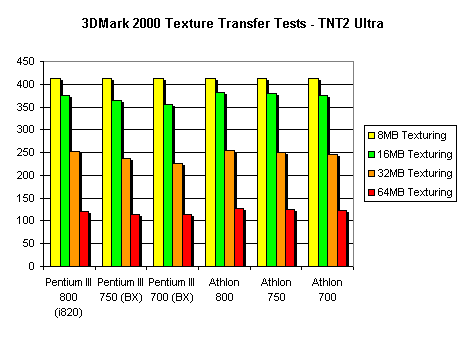
With full AGP 2X support with the TNT2 Ultra, the Athlon manages to beat out the Pentium III, clock for clock, in the texturing tests. The only setup that gives the Athlon competition here is the AGP 4X i820 platform running the Pentium III 800.

Testing at 640 x 480 helps to remove the graphics card as a bottleneck and focus the attention on the CPU. In this case, the Athlon takes a clear back seat to the Pentium III when armed with the GeForce.
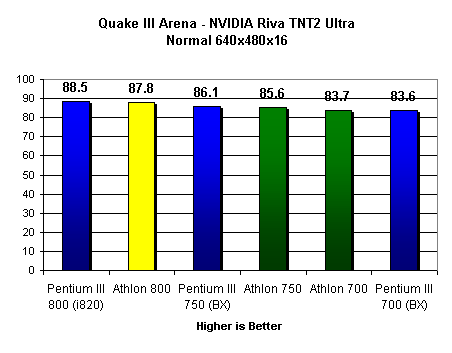
The Athlon 800 moves up one notch with the TNT2 Ultra, but still comes in 2nd to the Pentium III 800.

Increasing the resolution and color depth to a more realistic setup unfortunately maxes out the GeForce and thus the performance difference between the six CPUs is nonexistent.
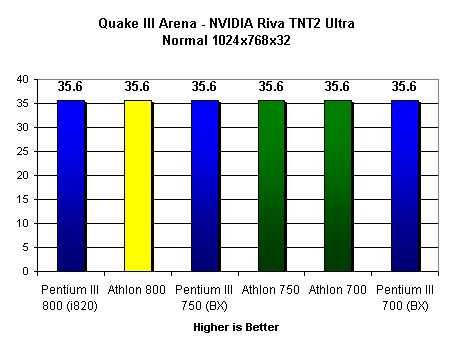
The same picture here.

With updated drivers we are seeing the Athlon outperform the Pentium III under UnrealTournament by a slight margin. The performance between the two platforms is very close however.
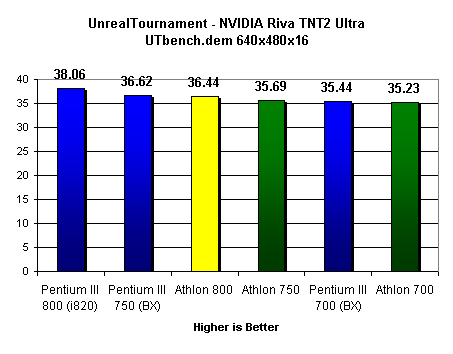
With the TNT2 Ultra, the Athlon just barely loses the lead it had over the Pentium III 750, 0.2 fps isn't worth arguing about.

Once again, we are seeing the limits of the GeForce 256 as we hit 1024x768x32.
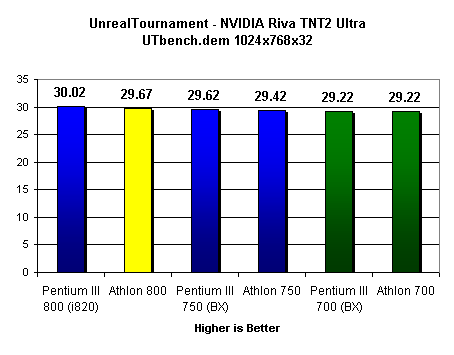
Truncating/rounding would produce the same picture with the TNT2 Ultra as we just saw with the GeForce 256.

Here we see a clear dividing line between the older BX setup and the newer contenders. Memory and system bus bandwidth play a very important role in the Expendable benchmark and thus we see the narrow victory of the Athlon 800 over the Pentium III 800 on an i820/RDRAM platform; and the noticeable performance lead of all three Athlons and the single i820 test system over the two BX setups.
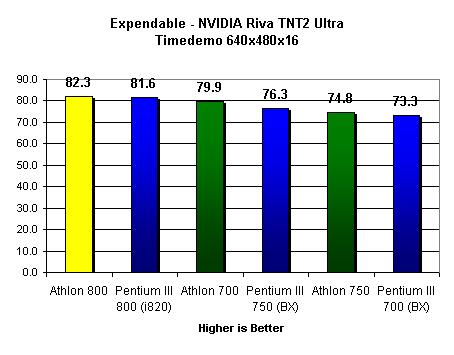
The Athlon holds the lead here as well.
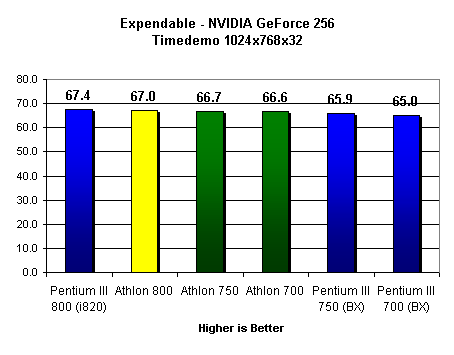
One fact about the Expendable timedemo is that the high resolution tests are wonderful for illustrating further performance differences between CPUs. While the performance of all of the CPUs is being hindered by the fill rate/memory bandwidth limitations of the GeForce 256, we can see the positive effects of the AGP 4X support and greater memory bandwidth of the i820 in that it helps give the test system the slight advantage over the AGP 2X Athlon 800 platform.

The TNT2 Ultra meets its match at the 1024x768x32 setting, there is no change between the CPUs in this fill rate/memory bandwidth limited test.
SPECviewperf
The Standard Performance Evaluation Corporation, commonly known as SPEC, managed to come up with a synthetic benchmark with real world implications. By running specific "viewsets" SPECviewperf can simulate performance under various applications. To be more accurate, according to SPEC, "A viewset is a group of individual runs of SPECviewperf that attempt to characterize the graphics rendering portion of an ISV's application." While this method is by no means capable of identifying the performance of a card in all situations, it does help to indicate the strengths and weaknesses of a particular setup.
SPECviewperf 6.1.1 currently features five viewsets: the Advanced Visualizer, the DesignReview, the Data Explorer, the Lightscape and the ProCDRS-02 viewset. Before each benchmark set we've provided SPEC's own description of that particular viewset so you can better understand what that particular viewset is measuring, performance-wise.
Each viewset is divided into a number of tests, ranging from 4 to 10 in quantity. These tests each stress a different performance element in the particular application that viewset is attempting to simulate. Since all applications focus on some features more than others, each one of these tests is weighted meaning that each test affects the final score differently, some more than others.
All results are reported in frames per second, so the higher the value, the better the performance is. The last result given for each of the viewsets is the WGM or Weighted Geometric Mean. This value is, as the name implies, the Weighted Geometric Mean of all of the test scores. The formula used to calculate the WGM is as follows:
![]()
With n being the number of tests in a viewset and w being the weight of each test expressed as a number between 0.0 and 1.0.
If you'd like to know more about why a Weighted Geometric Mean is used, SPEC has an excellent article detailing just why, here.
We ran the SPECviewperf 6.1.1 package under NT for a high-end workstation performance comparison. In order to place the strain on the CPU, we replaced the GeForce 256 with a regular TNT2 Ultra which does not feature any on-board geometry acceleration thus offloading all transforming & lighting requests onto the CPU.
Advanced Visualizer (AWadvs-03) Viewset
Taken from http://www.spec.org/gpc/opc.static/awadvs.htm
Advanced Visualizer from Alias/Wavefront is an integrated workstation-based 3D animation system that offers a comprehensive set of tools for 3D modeling, animation, rendering, image composition, and video output. All operations within Advanced Visualizer are performed in immediate mode with double buffered windows. There are four basic modes of operation within Advanced Visualizer:
- 55% material shading (textured, z-buffered, backface-culled, 2 local lights)
- 95% perspective, 80% trilinear mipmapped, modulated (41.8%)
- 95% perspective, 20% nearest, modulated (10.45%)
- 5% ortho, 80% trilinear mipmapped, modulated (2.2%)
- 5% ortho, 20% nearest, modulated (.55%)
- 30% wireframe (no z-buffering, no lighting)
- 95% perspective (28.5%)
- 5% ortho (1.5%)
- 10% smooth shading (z-buffered, backface-culled, 2 local lights)
- 95% perspective (9.5%)
- 5% ortho (.5%)
- 5% flat shading (z-buffered, backface-culled, 2 local lights)
- 95% perspective (4.75%)
- 5% ortho (.25%)
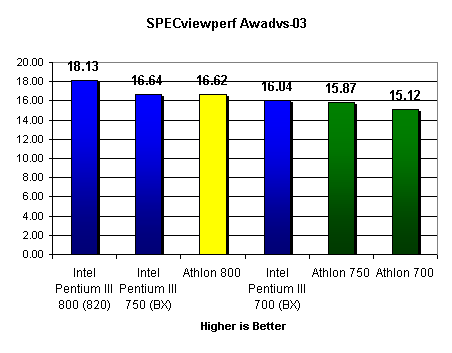
3D modeling and animation take advantage of the Athlon's superior FPU but at the same time seem to benefit more from the Pentium III's full speed L2 cache. The 1.6GB/s memory bandwidth made available by the i820/RDRAM platform also seems to have a positive effect on the results as the Pentium III 800 clearly distances itself from the competition.
DesignReview (DRV-06) Viewset
Taken from http://www.spec.org/gpc/opc.static/drv.htm
DesignReview is a 3D computer model review package specifically tailored for plant design models consisting of piping, equipment and structural elements such as I-beams, HVAC ducting, and electrical raceways. It allows flexible viewing and manipulation of the model for helping the design team visually track progress, identify interferences, locate components, and facilitate project approvals by presenting clear presentations that technical and non-technical audiences can understand. There are 6 tests specified by the viewset that represent the most common operations performed by DesignReview.

While the Athlon is still performing respectably, the Pentium III, even on the old BX platform is outperforming it on a clock for clock basis.
Data Explorer (DX-05) Viewset
Taken from: http://www.spec.org/gpc/opc.static/dx.htm
The IBM Visualization Data Explorer (DX) is a general-purpose software package for scientific data visualization and analysis. It employs a data-flow driven client-server execution model and is currently available on Unix workstations from Silicon Graphics, IBM, Sun, Hewlett-Packard and Digital Equipment. The OpenGL port of Data Explorer was completed with the recent release of DX 2.1.
The tests visualize a set of particle traces through a vector flow field. The width of each tube represents the magnitude of the velocity vector at that location. Data such as this might result from simulations of fluid flow through a constriction. The object represented contains about 1,000 triangle meshes containing approximately 100 verticies each. This is a medium-sized data set for DX.
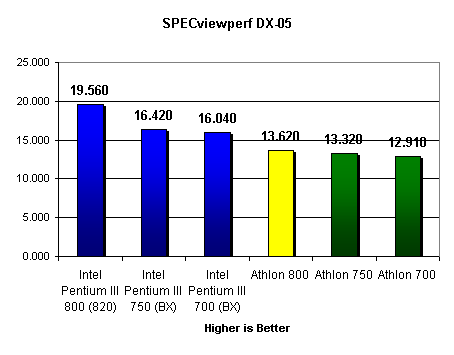
The Pentium III is completely dominating here, the Athlon needs a faster L2 cache in order to help keep up. The added memory bandwidth of the i820 chipset (courtesy of RDRAM) gives Intel an even more noticeable lead at 800MHz. While they weren't included, moving to an i840 platform with double the memory bandwidth would most likely yield a very impressive performance boost here as well.
Lightscape (Light-03) Viewset
Taken from: http://www.spec.org/gpc/opc.static/light.htm
The Lightscape Visualization System from Discreet Logic represents a new generation of computer graphics technology that combines proprietary radiosity algorithms with a physically based lighting interface.
There are four tests specified by the viewset that represent the most common operations performed by the Lightscape Visualization System
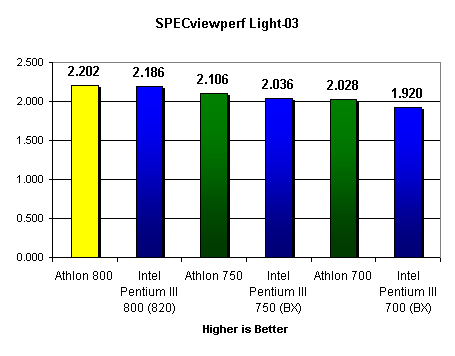
The Athlon 800 finally makes its way to the top of this test. All of the contenders perform respectably however you'd most likely see a greater improvement in this benchmark by simply adding a GeForce 256 to any one of the systems instead of upgrading the CPU.
ProCDRS-02 Viewset
Taken from: http://www.spec.org/gpc/opc.static/procdrs.htm
The ProCDRS-02 viewset is a complete update of the CDRS-03 viewset. It is intended to model the graphics performance of Parametric Technology Corporation's CDRS industrial design software.
For more information on CDRS, see http://www.ptc.com/icem/products/cdrs/cdrs.htm
The viewset consists of ten tests, each of which represents a different mode of operation within CDRS. Two of the tests use a wireframe model, and the other tests use a shaded model. Each test returns a result in frames per second, and a composite score is calculated as a weighted geometric mean of the individual test results. The tests are weighted to represent the typical proportion of time a user would spend in each mode.
All tests run in display list mode. The wireframe tests use anti-aliased lines, since these are the default in CDRS. The shaded tests use one infinite light and two-sided lighting. The texture is a 512 by 512 pixel 24-bit color image.
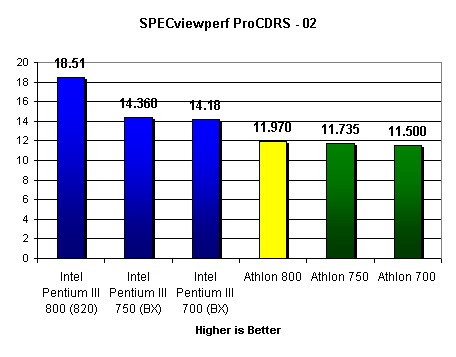
The scale tips in favor of Intel here once again.

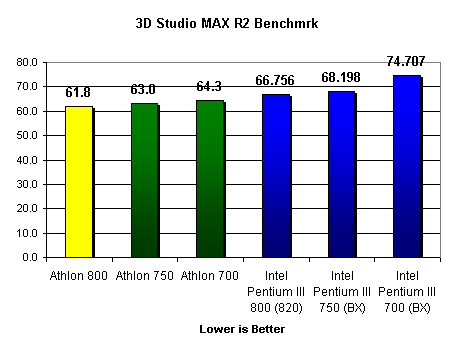
Under 3D Studio MAX AMD regains the performance lead we have been used to seeing from the Athlon. The raw FPU dependent nature of 3DSMAX gives the Athlon the edge here. AMD won't hold this lead for long if Intel keeps on beating them in L2 cache frequencies however.
Conclusion
Like the Athlon 800, the Pentium III 800 will begin shipping sometime early next year (most likely in January). But will it be the CPU for you? Currently, the 133MHz FSB Pentium IIIs are not worth the upgrade to if you currently have a BX setup. You're much better off sticking with your current setup and adding a 100MHz FSB Coppermine if you're really looking to upgrade your CPU.
The i820 and i840 platforms would be good foundations for a 133MHz FSB Pentium III system if it weren't for the steep cost of RDRAM, which is currently the only reason those two platforms don't get a recommendation here. At $1000 per 128MB, RDRAM is entirely too expensive for even a high-end user to user to justify the need for. VIA's Apollo Pro 133A chipset is the only alternative to 820/840 and for the price, it is a very attractive one, since you can re-use your old PC100 or PC133 SDRAM and still receive better than average performance.
Your best bet still is to stick with the BX platform for now, we would've never imagined that we'd be giving that recommendation over the i820 just a few months ago. It's funny how times change.
For more information on the new Pentium III 800 & 750, have a look at Sharky Extreme's review of the CPUs.







